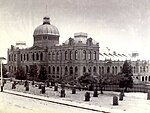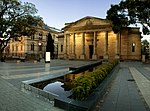Bonython Hall
Adelaide Park LandsBuildings and structures in AdelaideSouth Australian Heritage RegisterSouth Australian places listed on the defunct Register of the National EstateUNESCO Asia-Pacific Heritage Awards winners ... and 2 more
University of AdelaideUse Australian English from April 2015

Bonython Hall is the "great hall" of the University of Adelaide, located in the university grounds and facing North Terrace, Adelaide. The building is on the now-defunct Register of the National Estate and the South Australian Heritage Register. It is primarily used for University graduation ceremonies, examinations, expositions and public lectures and meetings likely to draw large audiences.
Excerpt from the Wikipedia article Bonython Hall (License: CC BY-SA 3.0, Authors, Images).Bonython Hall
North Terrace, Adelaide Adelaide
Geographical coordinates (GPS) Address Nearby Places Show on map
Geographical coordinates (GPS)
| Latitude | Longitude |
|---|---|
| N -34.920548 ° | E 138.605396 ° |
Address
University of Adelaide
North Terrace
5005 Adelaide, Adelaide
South Australia, Australia
Open on Google Maps






